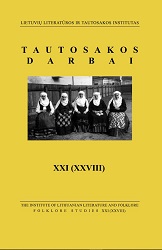Nuliejimas žemei: gėrimo apeigos adresato klausimu
Libation to Earth: Regarding an Addressee of the Drinking Ritual.
Author(s): Daiva VaitkevičienėSubject(s): Customs / Folklore
Published by: Lietuvių literatūros ir tautosakos institutas
Keywords: Ritual drinking in the Baltic religion; like in those of Germans; Slavs and ancient Greeks;
Summary/Abstract: Ritual drinking used to play a very important part in the Baltic religion, like in those of Germans, Slavs and ancient Greeks. Ritual drinking accompanied making of contracts, offering sacrifices, etc. The basis of the Baltic drinking ritual consists of a chain of certain ritual actions, interspersed with ritual texts. At the start of the ritual, the first drops of a drink used to be poured down onto the ground. What deities these could have been meant for? There could have been several potential addressees: 1) the Earth deity, 2) the home deity, and 3) the souls of the deceased. The author of the article argues that only libation for the first addressee – the Earth deity – could be considered as having a universal meaning: it could be performed during various rituals, both communal and private, and also during assorted calendar festivals. Whereas the home deities used to be honored at home only, and souls of the deceased also had their special festivals. What Earth deities could have this ritual libation been performed for? In Lithuania Minor this used to be the female earth goddess Zemynele, although there is some collateral evidence (presented by J. Lasicki and M. Stryjkowski) of the existence of male earth gods as well, such as Zemininkas and Raugu Zemepatis in Samogitia. Coherence seems to be lacking on Latvian territory in this respect as well: both the female Zemes mate (in Vidzeme) and the male god Cerroklis (in Latgala) have been recorded. Such differentiation could be determined by regional peculiarities. Manifestations of the Earth deities get also discussed in the article. The libation for Zemynele used to be accompanied by a short prayer, wherein she was praised as the blooming, flowering one. The motive of flowering is also prominent in Lithuanian drinking songs from a much later period, the 19th-20th centuries, which describe the drinking cup as having flowered in one’s hands; the ritual connection between drinking and flowering gets obvious here. The name of the Latvian god Cerroklis is related to the Latvian word cers ‘bush’, cf. Lithuanian keras ‘bush’, keroti ‘get bushy, ramify’; most probably it is associated to the plentiful harvest. The same meaning is inherent in the name of Lithuanian crops goddess Krumine (derived from krumas ‘bush’), which was allegedly an epithet for the goddess Zemynele. The author of the article also raises an assumption of the exclusive status of the Earth deity during the drinking rituals probably being motivated by its close connections to the food and drink culture, the consumption of agricultural products. This assumption is also supported by the evidence of the first drops of the freshly produced ritual drink (e.g. beer) being offered precisely to the Earth deities: Zemynele in Lithuania Minor, Zemes mate in Latvia, and Raugu Zemepatis in Samogitia.
Journal: Tautosakos darbai
- Issue Year: 2004
- Issue No: 28
- Page Range: 104-117
- Page Count: 14
- Language: Lithuanian

